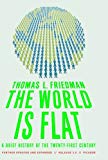
The World Is Flat is a book by Thomas Friedman discussing the trends of globalization in the 21st century. Friedman describes himself as a "free-trader," arguing in favor of the rapid shifts towards a more interconnected economic world after the fall of the USSR as a result of the Internet, computers, outsourcing and workflow software. Friedman also presents his controversial Dell Theory of Conflict Prevention: that corporations' increased dependency on foreign labor and resources will prevent armed conflict.
We are introduced to Friedman’s interpretation of the ten influencing factors that led to globalization and world flattening, the first being the falling of the Berlin Wall in 1989, which tipped the balance of power across the world towards democratic free market and away from authoritarian rule. A second flattener is identified as our ability to not only author our own content, but to send it worldwide with the 1995 launch of the Internet. Subsequently, free workflow software was developed, allowing people from around the world to collaborate and work together on projects using a shared medium. As Apache and Wikipediacame into play, we became able to develop and upload web content and community collaboration became another flattening force. Preparations for Y2K required resources beyond those available in the United States and as a result, we see that India became responsible for a huge portion of these preparations. Offshoring, using the Chinese manufacturing sector as a prime example, has forced other developing countries to try to keep up with their low cost solutions, resulting in better quality and cheaper products being produced worldwide.
The seventh flattening factor is our introduction to supply chaining, which is discussed in much greater detail later in Chapter Fourteen. Rounding out his list with insourcing, in-forming and“the steroids”, Friedman examines his flattening factors, their origins and the effect they will have on the way we do business in the future.
Already have an account? Log In Now